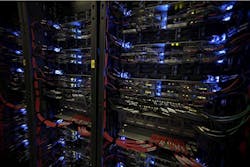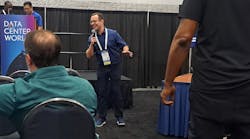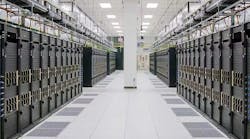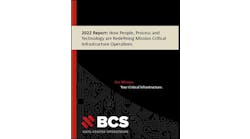At Data Center Frontier our eyes are on the horizon. We’ve spent much of 2017 talking with industry thought leaders about what’s next for the industry.
We’ve identified eight themes that will shape the data center business in 2018. We’ll be writing in more depth about many of these trends over the next month, but this list provides a high-level view of the topics that we believe will be relevant this year.
1. On-Premise Workloads Migrate into Cloud and Colo
It seems like we’ve been talking about this forever. It doesn’t even seem like a sexy topic any more. But the long-predicted migration of enterprise IT workloads into third-party data centers has finally arrived, and its impact on business for cloud and colocation providers will be sexy indeed.
“We’re in the middle of a major architectural shift,” said Sami Badri, a Senior Equity Analyst at Credit Suisse who tracks the data center sector. “During this transition, there is a lot of opportunity for colo providers to take on a lot of workloads.”
This shift has been predicted with the arrival of a succession of hosting offerings, and has always seemed to linger on the horizon. But make no mistake: Enterprises are getting religion about moving workloads off-premises. The trend accelerated in 2017, and will continue in earnest in 2018, creating sustained business for IT infrastructure providers.
Why now? The options have never been better. The cloud and colocation industries have reached a level of maturity that offers compelling value, breaking down the historic resistance to moving data offsite. The notion that in-house data centers are more secure than the cloud has been punctured by a series of corporate data compromises. And while some media are depicting this week’s Meltdown/Spectre security issue as a cloud problem, early evidence suggests that cloud platforms will emerge touting the speed of their remediation (at least versus enterprise IT infrastructure).
An accelerating factor is the aging of on-premises facilities. Construction of these capital-intensive projects slowed dramatically after the financial crisis of 2008, and a growing number of companies are facing decisions about their infrastructure. “It’s very rare that we talk to anyone who wants to build their own data center,” said Kristina Metzger, a Data Center Specialist at CBRE. “The move towards outsourcing is real.”[clickToTweet tweet=”Kristina Metzger of CBRE: It’s very rare that we talk to anyone who wants to build their own data center.” quote=”Kristina Metzger of CBRE: It’s very rare that we talk to anyone who wants to build their own data center.”]
Some workloads will head to the cloud. Many other workloads are not cloud-ready – and may never be – and thus will move to colocation facilities.
“Ultimately, it’s about applications,” said Raul Martynek, the CEO of DataBank. “Most enterprises still have the majority of their applications written in legacy languages. That’s part of the dynamic that pushes the hybrid strategy. There’s still a lot of enterprise outsourcing that needs to happen.”
2. Latency Reshapes Cloud Infrastructure
Most major cloud campuses have been closer to cows than cities, driving data center building booms in rural areas of Oregon, Iowa and North Carolina. That’s starting to change, as rapid growth and new workload profiles require that data be housed closer to end users.
“Latency is becoming problematic,” said Phill Lawson-Shanks, the Chief Architect & Vice President of Innovation at EdgeConneX, which focuses on the edge computing market but also builds facilities for major cloud players. “It’s forcing a shift with the hyperscalers to move services closer to the users. We’re now seeing regional hyperscale nodes of 20 to 60 megawatts in Ashburn and Chicago.”
Hyperscale players have always housed capacity in major markets, but have often chosen to lease space from wholesale providers rather than build their own campuses. As cloud demand shifts workloads closer to population centers, larger footprints are needed in these markets. This may prompt hyperscalers to build rather than buy.
This trend is a likely factor in recent land purchases by Microsoft in Silicon Valley and Google in Northern Virginia, markets where they have previously leased space. Microsoft also has a 30 megawatt build-to-suit project in suburban Chicago, according to Jim Kerrigan, Managing Director at North American Data Centers.
“They could build that in Iowa, but they didn’t,” said Kerrigan. “For the cloud guys, the edge is in Chicago.”
That’s probably good news for data centers in Dallas, where nearly all the major wholesale players are building large campuses. The Dallas-Fort Worth metroplex hasn’t been a huge hyperscale market, but Lawson-Shanks says Dallas and Phoenix are two markets positioned to benefit from latency-driven cloud buildouts.
3. Wireless, Data Center Industries Meet at the Edge
The acquisition of Vantage Data Centers in 2017 highlighted the growing overlap between the data center and wireless worlds. The acquirer was Digital Bridge, which has a long history in the wireless antenna and tower sector, and is pushing into data centers with its acquisitions of Vantage, DataBank and C7 Data Centers.
Other rising data center players with wireless pedigrees include EdgeConneX and Stonepeak Infrastructure Partners, which acquired Cologix. Meanwhile, telecom tower companies are forging joint ventures with specialists in edge computing.
An illustration of a Vapor Edge Module deployment, which merges software and hardware in a holistic edge design. (Image: Vapor IO)
We see this trend gaining momentum in 2018 and beyond. The impending arrival of 5G wireless networks will be an enabler of new technologies that shift IT infrastructure outside of core markets, and require additional integration between data centers, telecom towers and antennas. Analytics for new technologies will require processing and storage, sorting oceans of sensor data into smaller datasets to send across the network.
“The data center world is on a collision course with the wireless world,” said Hugh Carspecken, CEO of DartPoints, a provider targeting the micro data center opportunity. “The key here is that you’re starting to see brand new applications and datasets. Demand (for data storage) is not at the cell tower yet, but it is pushing further out. The ecosystem is still being defined. You’ll see that ecosystem come together, laying the groundwork for the autonomous cars to come.”[clickToTweet tweet=”DartPoints CEO Hugh Carspecken: The data center world is on a collision course with the wireless world. ” quote=”DartPoints CEO Hugh Carspecken: The data center world is on a collision course with the wireless world. “]
“The way the edge gets deployed is part data center infrastructure and part network infrastructure,” said AJ Byers, CEO of ROOT Data Center in Montreal. “These two kind of have to work together.”
4. AI Hardware Everywhere, From the Data Center to the Device
Artificial intelligence was a big trend in 2017, as just about everyone sought to leverage machine learning to enhance their products and services. In 2018, we’ll see the AI boom continue to drive new hardware offerings, both in hyperscale data centers and in the devices in our pockets.
In the data center, Intel’s Nervana Neural Network Processor (NNP) will become widely available this year, while NVIDIA continues to innovate on its GPU-based offerings and chips, as well as a growing set of next-generation chips from both existing vendors like AMD and the ARM ecosystem, and a promising group of startups. One newcomer to watch is Cerebras Systems, a well-funded startup led by Andrew Feldman, who is familiar to data center watchers from his leaderships of low-energy chip startup SeaMicro.
A row of eight NVIDIA graphics processing units (GPUs) packed into a Big Sur machine learning server at Facebook’s data center in Prineville, Oregon. (Photo: Rich Miller)
AI is also moving to the device level. Startup Mythic, which we profiled last summer, is among a group of startups building chips for device-based processing of neural networks. Mythic and its cohorts aspire to shift computing power and algorithms out of the data center and onto smartphones and tablets, as well as appliances on factory floors and hospitals. The evolution of edge devices and “fog computing” – processing power near the perimeter of the network – will play a role in the geography of the Internet of Things, helping to deliver capacity to billions of devices and sensors.
It’s too early to say exactly how this trend will impact the data center, but history suggests that demand at core data hubs will continue to grow as edge devices become more powerful.
5. Opportunities Emerge in Next-Generation Tech
Cloud and enterprise are driving the headlines. But next-generation technologies like the Internet of Things, blockchain and bitcoin, genomics, robotics, drones and autonomous cars are taking shape, and data center operators are closely tracking the opportunities in these sectors, which typically emerge in clusters around geographic development hubs.
“What I’ve seen over the last year is glimmers of the net new workloads,” said Martynek, the CEO of DataBank. “Thus far, it’s pretty much been enterprise or cloud. Now we’re seeing a lot of deployments around AI, which requires a lot of processing power and storage. That workload didn’t exist five years ago. We’ve also see growing demand around computational research – biological and chemical processes assessed in data and software. That’s another workload that didn’t exist five years ago.”
“I think we’ve only started to scratch the surface,” said Martynek. “Things like the Internet of Things and robotics and autonomous cars are just in their infancy. I think we’ll see a lot more of these new workloads.”[clickToTweet tweet=”DataBank CEO Raul Martynek: We’ll see more new types of workloads. We’ve only started to scratch the surface. ” quote=”DataBank CEO Raul Martynek: We’ll see more new types of workloads. We’ve only started to scratch the surface. “]
“You have to pay attention, because these applications are changing very quickly,” said Andrew Schaap, CEO of Aligned Energy. “What they’re saying today could be totally different 180 days from now. Things are moving fast, and there’s a land grab going on. There’s a lot of business to go around.”
6. Consolidation Continues. Will Deals Remain Disciplined?
With more than $20 billion in acquisitions, 2017 was a record year for data center mergers, and the industry consolidation is likely to continue into 2018. The data center industry is increasingly about building platforms, and adding scale and capabilities along the way. Some acquisitions help providers expand into new geographic markets or position for future capacity in existing ones.
Beyond strategic considerations, there is a growing pool of global investors seeking to put money to work in the data center and cloud sector, providing ample liquidity. “There’s a lot more new money coming into the space than I’ve ever seen,” said Kerrigan of North American Data Centers. “It’s a little bit scary. But thus far, it’s been smart money.”
What’s the downside to strong investor interest? One concern is that new players may move to capture market share through aggressive pricing or speculative data center development. There’s been no sign of this to date, partly because new investors are working with experienced executive teams.[clickToTweet tweet=”Jim Kerrigan of NA Data Centers: There’s a lot more new money coming into the space than I’ve ever seen.” quote=”Jim Kerrigan of NA Data Centers: There’s a lot more new money coming into the space than I’ve ever seen.”]
One veteran data center investor says the competitiveness of recent M&A deals has made it difficult for some new investors to find an entry opportunity. That could prompt more aggressive bidding in 2018, which in turn could boost valuations.
“There are a lot of bridesmaids on the sidelines right now,” said Alexander Fraser, Managing Director of GI Partners, who spoke during an M&A panel at the recent IMN Forum in Chicago. “There are firms that will have missed on three or four of these toehold platforms. These firms probably may do something on pricing to come off the sidelines. ”
7. Hyperscalers Lead The Transition To Renewable Energy
Cloud computing has emerged as a surprising force for the commercialization of renewable energy at Internet scale. We expect to see this trend accelerate in 2018, as Google, Amazon, Microsoft and Apple are all committed to sourcing renewable energy to power their cloud data centers. This is typically accomplished with large power purchase agreements (PPAs) that help finance large solar or wind generation projects.
Solar panels at a data center in New Jersey. A high level of insight is needed to estimate needs, understand the market, and identify the correct procurement path moving forward. (Photo: Rich Miller)
In 2017 we saw a dialogue between data centers and utilities that may bear fruit in the coming year.
“In 2018, expect data center companies and energy utilities to partner to deliver true renewable energy options,” said Jim Leach, Vice President of Marketing at RagingWire Data Centers. “Look for the leading data center companies to ‘walk the walk’ and roll out affordable renewable energy options as part of their colocation offerings. ”
The renewable options are improving in major data center markets that have historically relied on fossil fuels or nuclear power for the bulk of their generation. Case in point: The state of Virginia, where Facebook has worked with Dominion Energy Virginia to create a renewable power rate that will allow large energy users like data centers to more easily provision energy from renewable sources.
8. NIMBY Issues Become More Pronounced
The pace of data center development has prompted a growing number of local disputes, as residents seek to block or revise plans to build new facilities in their town. These NIMBY (Not in My BackYard) disputes have emerged over the years, but saw an upswing in the second half of 2017. Expect to see more headlines about data center controversies in 2018.
The most notable case has been Apple’s attempt to build a $1 billion data center campus in Athenry, Ireland, which was announced in February 2015 has been repeatedly delayed by disputes in local boards and regional courts. The dispute went all the way to Ireland’s High Court, which recently ruled that Apple can proceed. The objections from residents have focused on environmental issues and Apple’s use of energy.
There have been similar issues in the U.S. most notably in Northern Virginia, where a community group has fought a power line expansion to support an Amazon Web Services project in Haymarket in Prince William County. There has also been organized opposition to a Compass Datacenters project near Leesburg in Loudoun County.
Expect to see more of these disputes in 2018 as data centers gain a higher profile as economic development projects, and communities become aware of previous disputes.






